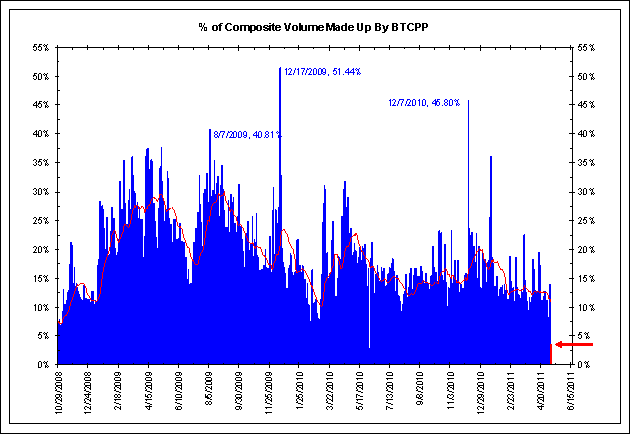<Click on chart for larger image>
- MarketWatch.com – Citi’s reverse split has tiny impact on volume
Moving from worst to just bad, the NYSE composite volume is the trading volume of all the issues who are members of the NYSE. This is what most people think of when looking at volume. It includes all the shares of NYSE listed stocks no matter where the trades were facilitated. So the effect of Citigroup’s split will be somewhat muted but still significant, attributing typically close to 10% of the total NYSE. When referring to the market volume, other media outlets may reference the total composite volume of all shares traded on all the major exchanges. Using this view, Citigroup’s split should decrease the total by about 4%. These are the three common methodologies. Keep in mind that these are generalities. Each data provider may modify the data by being either over-inclusive (adding exchanges) or restrictive (subtracting issues ADRs, ETFs, non-operating companies, etc.). Many acknowledge the predictive benefits of using volume data, yet few actually apply the data correctly. However, serious volume watchers use either dollar totals or capital weighted figures in analyzing volumes.
Comment
<Click on chart for larger image>



The chart above shows composite volume for the S&P 500 stocks only, our preferred measure of volume. The two brown bars show Monday and Tuesday’s volume, after the Citi split. Monday’s volume was the lowest non-holiday volume since we started this measure in 2008.
The chart below shows the percentage of volume coming from financial stocks that accepted TARP money (BTCPP <Index> on Bloomberg). Citi was one of the largest financial institutions to accept TARP funds. Collectively these institutions (which totals 199) average between 10% and 15% of NYSE composite volume. In the two days since Citi’s reverse split, these companies have accounted for less than 5% of NYSE composite volume (red bars and arrows).
Citi’s reverse split is having a significant effect in depressing volume and will continue to do so moving forward.